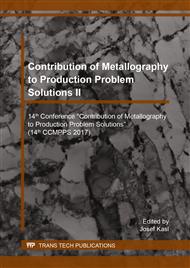p.3
p.15
p.21
p.27
p.34
p.39
p.45
p.52
p.57
Structural Changes of Hot Work Tool Steel due to Heat load
Abstract:
The paper deals with the influence of thermal load on functionality of the Toolox 33 hot work tool steel equivalent to the materials of W.Nr. 1.2311, 1.2312, 1.2738 and P20 in order to assess its suitability as a material for glass manufacture preform. Using light and electron microscopy it was shown that the steel was highly unfitting for this application where the steel comes into contact with the hot glass. Regarding the evaluation of the microstructure, it was shown that intense decarburization reflecting on the fracture behaviour of the surface layer during the thermal load has occurred. This fact was confirmed by a static tensile test and hardness measurements. Moreover, the thick layer of flakes has formed on the surface.
Info:
Periodical:
Pages:
34-38
Citation:
Online since:
November 2017
Authors:
Keywords:
Price:
Сopyright:
© 2017 Trans Tech Publications Ltd. All Rights Reserved
Share:
Citation:


